Lasers and Cancer
Time domain multi-wavelength diffuse optics: Towards a comprehensive approach for breast cancer management (CUSBO, Italy)
Breast cancer is the most frequently diagnosed cancer in the vast majority of countries and is the leading cause of cancer death in over 100 countries worldwide (Global Cancer Statistics 2018: GLOBOCAN). Early diagnosis is key for a high survival rate. Treatment modalities are changing to achieve efficacy, while minimizing invasiveness. In the last years, prevention is also drawing more and more efforts aiming at maximising women’s quality of life and the sustainability of healthcare systems.
Diffuse optical spectroscopy (DOS) carried out in the time domain allows the non-invasive assessment of the optical properties (absorption and reduced scattering) of highly diffuse media, like in vivo biological tissues. Measurements performed at repeated wavelengths can then yield the estimate of tissue composition and physiologic parameters, and provide information on tissue microscopic structure. Thus, DOS offers unique potential for non-invasive in vivo pathophysiological investigation.
Prevention – Breast density is a major independent risk factor for developing breast cancer. It is currently assessed through the analysis of X-ray mammographic images and thus generally it becomes known at the age of 50 or later. Conversely, knowing it earlier in life would allow designing dedicated diagnostic paths for women at high risk and, even more important, preventive interventions to reduce the risk with drugs or lifestyle changes.
A clinical DOS imaging system, operated in the time domain at 7 discrete wavelengths in the range of 635-1060 nm, was developed by the CUSBO facility at Politecnico di Milano. Applied in a clinical study involving more than 200 patients, it allowed us to show that optically derived parameters correlate to a high degree with both qualitative and quantitative estimates of mammographic density (i.e. BIRADS categories, typically used by clinicians, and percentage density, respectively). Specifically, the instrument developed at Politecnico di Milano, unique at international level, allows the estimate of blood parameters (total volume of hemoglobin and oxygenation level) and of the average composition of tissue not only in terms of water and lipid content, but also of collagen content. The study demonstrated that collagen contributes fundamentally to breast density. Furthermore, collagen amount and type has also been suggested as an independent risk factor for breast cancer. So the approach to DOS followed at Politecnico di Milano may offer unique potential for understanding breast cancer risk and developing prevention strategies.
Diagnosis – Mammographic screening is effective in detecting early cancers, but is affected by limited specificity, often leading to further unnecessary (typically invasive) examinations. In a 2017 clinical study, full-breast images were collected (see figure) that were analysed to identify differences in composition between malignant and benign lesions. A statistical approach based on the Discrete Ada- Boost procedure exploiting information derived from optical data and from the patient’s history proved able to classify malignant versus benign lesions with sensitivity of 88% and specificity of 79%. Again, optically assessed collagen content was identified as the most important parameter for the discrimination.
Therapy monitoring – Neoadjuvant chemotherapy is becoming more and more widespread to reduce tumor volume (making surgery more conservative) and even achieve pathologic complete response. Unfortunately, a high percentage of women do not respond to therapy, but that becomes known only at the end of several therapeutic cycles. Effective techniques for therapy monitoring and early prediction of pathologic outcome are not avail- able yet in clinical practice, but the ability of DOS to non- invasively estimate tissue composition has already shown interesting potential. In this line, the detection chain of the optical mammograph developed by Politecnico di Milano was recently upgraded, relying on Silicon photomultipliers for photon detection and on high throughput time-to- digital conversion for data acquisition. This improved the signal level, especially at the longest wavelength (1060 nm), which is important for sensitivity to collagen. The instrument has just started an initial clinical study to investi- gate its potential in therapy monitoring and prediction of pathologic outcome.
Paola Taroni (CUSBO-Politecnico di Milano)
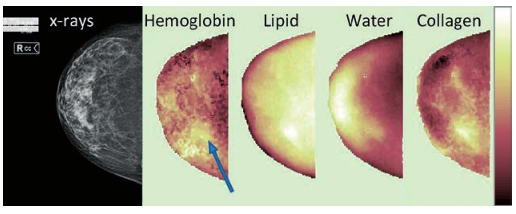
Two-photon lithography in cancer research (ILC, Slovakia)
The complexity and dynamic nature of cancer pose many challenges for the experimental designer who wishes to efficiently decipher some of the unknowns in cancer development and progression and pave the way to new prospective anti-cancer therapies. Experimental research on cancer has for many years relied on in-vitro models consisting of cancer cells grown in 2D monolayers, typically on plastic flat surfaces. However, many studies have shown that these models are too simplified to represent the many key factors involved in tumor progression. There is a clear need for in-vitro models better mimicking the physiological conditions seen in native cancer tissues. In-vitro models based on 3D cell cultures seem to meet this requirement, and recently they started to be extensively utilised in experimental cancer research.
To study processes occurring at the single-cell scale, the scaffold structure is often required to have comparable dimensions, which is not trivial. One suitable fabrication technique is two-photon lithography. The technique exploits the two-photon absorption (2PA) process to solidify a liquid photosensitive polymeric material by photo-polymerisation. 2PA occurs if the spatial and temporal density of the photon flux is sufficient to induce a simultaneous absorption of two photons by a molecule of the photo- sensitive material. This is usually achieved in the focus of a femtosecond pulsed laser. 2PA activates radical initiation and propagation reactions in the exposed polymer, result- ing in the resist polymerisation. The volume in which polymerisation occurs is proportional to the size of the laser focus. The movement of the laser focus through a volume of polymeric material progressively photo-polymerises the liquid material and finally creates a solid 3D structure. The non-polymerised (unexposed) material is then washed out with an appropriate solvent and the photo-polymerised solid structure is prepared for the next application. Any polymer comprising monomers that are able to photo- polymerise in the presence of a suitable photo-initiator can be used in 2PA lithography [1].
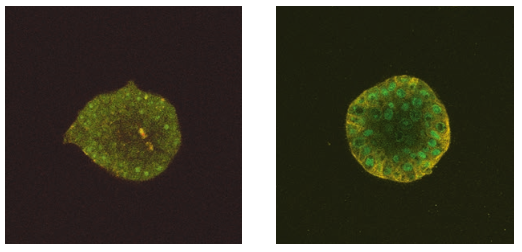
Morphology of 3D clusters of KYSE 450 cells in collagen type I (left) and Matrigel matrices (right) imaged by confocal microscopy. The cells were stained with Acridine orange (green) to visualise intracellular organelles and Cell mask to visualise cellular membranes (orange).
The biocompatibility of the scaffold material and maintaining the properties of cells residing in resulting 3D scaf- folds are the main clues when investigating cellular pro- cesses in 3D space. Freshly prepared scaffolds often lack proper surface chemical properties and are toxic to cells, so further surface functionalisation of the scaffold need to be performed to achieve an optimal combination of chemical and morphological characteristics for cell seeding, which is one of the research areas of the ILC group in this field [2]. 2PA lithography offers a number of advantages over other fabrication techniques, particularly if the ultimate resolution of fabricated structures plays a key role. A high degree of control over the shape and porosity of fabricated structures allows the preparation of near-biomimetic struc- tures with feature sizes in micrometers and overall dimensions on the order of millimeters. 2PA can create microenvironments with highly controlled and reproducible porosity, by intersecting polymeric rods to create scaffolds with different pore sizes. This 3D geometrical assembly, known as a woodpile structure, can be obtained in a single fabrication step with 2PA, while a similar complexity is difficult to achieve with planar micro-fabrication approaches. Woodpiles fabricated with 2PA have been used for various applications, including the study of cell motility and migration in 3D, a process highly influenced by the mechanical interaction between the cell and the extracellular environment. In conclusion, 2PA technology seems to be apromising tool to generate in-vitro 3D models for analysis of tumor-immune system interactions in highly controlled conditions, considering the recognised roles of several factors of tumor archi- tecture and microenvironment in tumor biology [3].
Anton Mateašík, Dusan Chorvát, Beáta Čunderlíková (ILC) and Tibor Teplický (Comenius University)
[1] T. Teplicky et al., Proc. SPIE 10142: 101420C-1-8, 2016
[2] T. Teplický et al., Biointerphases 13: 041009, 2018
[3] T. Teplicky et al., Proc. SPIE 11271: 1127111, 2020
Lasers and cancer detection: Label free nonlinear microscopy for tumour cell visualisation (LaserLaB Amster-dam, The Netherlands)
Distinguishing tumour from normal tissue is important to improve surgical results. Researchers at Laserlab-Europe partner LaserLaB Amsterdam use second- and third harmonic generation microscopy to identify tumour cells in brain and lung tissue within seconds.
A rapid and reliable histological typing can reduce operation time and potentially improve surgical patient outcomes. The currently used intra-operative technique for providing fast feedback about the nature of the excised tissue and resection margins is frozen section analysis, which takes 45-60 minutes. Surgical results could be improved when having a faster pathological grade diagnosis of tissue available during surgery.
Second and third harmonic generation microscopy (SHG and THG) combined with 2- and 3-photon excited auto-fluorescence microscopy shows great potential as a clinical tool for the real-time assessment of the pathological state of tissue during surgery: the relative speed of the imaging modalities approaches ‘real’ time, and no preparation steps of the tissue are required.
THG and SHG are coherent multiphoton processes. The efficiency of THG depends mainly on the third-order susceptibility χ (3) of the medium and the phase-matching conditions. In practice, cell membranes and cell nuclei are clearly displayed with THG microscopy, since they contain lipids which are known to have a high χ (3) . SHG contrast de- pends on the second-order susceptibility, χ (2) . Only media with a non-centrosymmetric molecular organization have a non-zero χ (2) . For example, a strong SHG source is collagen. Since the THG nonlinear signals are proportional to the cube of the applied laser intensity (I 2 for SHG), femtosecond laser pulses are required to generate a high peak power, while keeping a low average power. As the nonlinearity of the optical signals ensures they are only efficiently generated in the laser focal spot, this provides intrinsic confocality. A small focal spot volume results in a high submicron resolution and provides direct depth sectioning resulting in full 3D images of the tissue.
THG and SHG microscopy were used in combination to detect healthy and diseased states in fresh excised brain and breast tissue. Normal and malignant human brain tissue were successfully discriminated, based on histopathological hallmarks such as increased cellularity and nuclear pleomorphism. Glioma infiltration has also been qualitatively detected by applying automated image analysis (see Zhang et al.).
These experiments have been performed in the laboratory, with the excised tissue brought to the lab within 20 minutes after surgery. The next step is to explore the added value of instant feedback on the nature of excised tissue during surgery. The VU spin-off company Femto Diagnostics B.V. has developed a mobile version of the THG/ SHG microscope. This machine has been brought into the lung endoscopy suite of the Amsterdam Universities Medical Center for a first test, and a study with this microscope was completed on ex-vivo fresh unprocessed lung tissue (submitted for publication). Alveolar structures and histopathological hallmarks, cellular structures (THG), collagen (SHG), and elastin (2PEF), were imaged within 1-3 seconds using a power of only 5 mW (see figure). Comparing the generated images of tumorous and non-tumorous lung tissues with the corresponding standard histology showed excellent agreement.
Laura van Huizen, Zhiqing Zhang and Marloes Groot (LaserLab Amsterdam)
Z. Zhang et al.: Adv. Sci. 6: 1900163, 2019
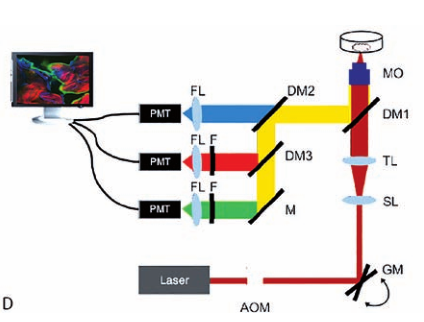
Multiphoton microscope setup: Femtosecond laser;GM – X-Y galvo-scanner mirrors; SL – scan lens; TL– tube lens; MO – microscope objective; DM1 –dichroic mirror.
Photodynamic therapy and cancer (CLL, Portugal)
Photodynamic therapy (PDT) consists in the administration of a dye (referred to as a photosensitiser) and its subsequent activation with light. The photosensitiser does not have any pharmacological effect in the dark, but when electronically excited rapidly undergoes intersystem crossing to the lowest triplet state, from which it has time to react with nearby oxygen molecules, either by energy transfer (Type II process) to form singlet oxygen or by electron transfer (Type I process) to form a superoxide ion. Other reactive oxygen species (ROS) are subsequently formed by dark processes and then react with biomolecules within a radius of 200 nm before being deactivated. Hence, PDT produces a localized oxidative stress that triggers various cell death mechanisms. PDT is a major use of laser sources to treat cancers, and has also been used in the inactivation of bacteria, fungi and viruses.
The origins of PDT can be traced back to 4000 years ago when ancient Egyptians ingested plants containing light- activated psoralens and exposed themselves to sunlight to treat vitiligo. The photodynamic effect was first reported in the scientific literature in the beginning of the 20th century after the observation by Oscar Raab, working in the laboratory of Hermann von Tapiener, that illuminating microbial cultures in the presence of acridine compounds induced microbe death. The initial interest in the photodynamic effect was offset by the success of antibiotics in the treatment of bacterial infections. The current era of PDT began with studies by R. L. Lipson and S. Schwartz at the Mayo Clinic in 1960 who observed that injection of crude preparations of hematoporphyrin led to the fluorescence of neoplastic lesions visualised during surgery. Schwartz realized that a purified fraction of hematoporphyrin derivatives could be used as a photosensitising agent to destroy tumour tissue. Thomas Dougherty identified and purified the most active derivatives to obtain a photosensitiser named Photofrin®, and led the first clinical study that showed conclusive clinical benefits of PDT in the treatment of solid tumours.
Photofrin® was first approved for clinical treatments in Canada in 1993 and other approvals in major markets followed rapidly. Today, dozens of photosensitisers have been approved, or are in active clinical trials, for the treat- ment of solid tumours. One of these photosensitisers, named redaporfin, was issued from the Coimbra LaserLab. PDT also enjoys widespread use in the treatment of skin lesions such as actinic keratosis and basal cell carcinoma. Interestingly, the dramatic increase in antibiotic resistance has led to a revival of antimicrobial PDT in the last decade. Its use in periodontal diseases and in the treatment of acne is becoming popular. More recently, the PDT community joined many other efforts to control Covid-19. The remarkable range of application of PDT can be explained by its fundamental mechanism: the ability to produce controlled oxidative stress when and where desired by simply controlling a laser confers specificity in the destruction of tumour cells, bacteria/fungi or virus.
Cancer remains the major focus of PDT. The challenges ahead are related to the limited penetration of light in human tissues and to the specificity of the photosensitisers to the elected targets. Light penetration in tissues increases with the wavelength of light in the visible and near-infrared but it is difficult to prepare photosensitisers with strong electronic absorptions in the infrared. Two-photon absorption may be the solution in the future, and medical lasers for such applications are needed.
Luis G. Arnaut (CLL)

Photoacoustic tomography of CT26 tumors subcutaneously implanted in BALB/c mice before and after photodynamic therapy with redaporfin when this photosensitiser is in the vasculature. Red: oxyhemoglobin; blue: deoxyhemoglobin. The average amount of oxyhemoglobin in the region of interest is reduced with PDT as a result of the destruction of the tumour vasculature. Under these conditions ca. 95% of the mice are cured.
Radiobiology experiments with laser-accelerated ion beams (LULI, LOA, France, CLF, UK and collaborators)
Investigations of the response of biological samples to irradiation with laser-accelerated ion beams have been carried out in the last few years in the frame of a collaboration between different European partners, namely the LULI, LOA, Laboratory for Optics and Biosciences (LOB) in France, the Queen’s University Belfast and the Central Laser Facility (CLF) in the UK, and the University of Naples Federico II and the LNS-INFN laboratory in Italy. These studies are of relevance to assess the potential viability of hadron-therapy applications for laser-driven ion sources.
Since the completion of the first clinical facilities in the early 90s, hadron therapy has become a well-established methodology for cancer treatment, the main advantage in comparison to photon-based radiotherapy lying in the ability of ion beams to deliver peak radiation doses at the tumour while minimising damage of the surrounding healthy tissues. The size and the considerable costs of cyclotron and synchrotron accelerators, however, have so far hampered a wider diffusion of hadron therapy clinical facilities [1]. Hence, there is a growing interest towards finding viable compact and cost-effective alternatives to accelerate particles for medical applications, and laser-driven particle accelerators have recently been proposed as a possible candidate. Clearly, before any medical application can be realistically considered, the radiobiological effectiveness of irradiation at the considerably higher dose rates provided by these short pulse sources must be assessed.
In this context, extensive experimental work has been carried out within the research network. A more detailed presentation of the previous work is available in the al- ready published work [2-5], but it is worth mentioning here some of the milestones already achieved by the project: Part of the investigation has been dedicated to the optimization of laser-driven ion sources for radiobiological applications and to study the feasibility of novel acceleration schemes. This is an open area of research, which will take full advantage of the new high-power laser facilities soon to become operational at different locations in Europe, such as the ELI European laser facilities and the Apollon system in France.
Different schemes for the transport and shaping of laser-accelerated ion beams and integrated dosimetry systems to control the delivered radiation dose have been successfully exploited in these experiments. Protocols for the manipulation and handling of biological samples in laser facility target areas have been established for a variety of cellular types and irradiation architectures. For instance, in experiments carried out at the CLF and at LULI, the effectiveness of laser-driven proton beams were investigated in the induction of DNA DSB damage in the human normal skin fibroblasts and patient derived-radioresistant tumour Glioblastoma stem cells, both in hypoxic and normoxic conditions, and the radio- biology of laser-accelerated carbon ions in the radiation resistant glioblastoma stem cells were studied. In a recent experiment, methods were exploited for the irradiation of 3D neuro-spheres and 2D monolayers of glioblastoma stem cells (see figure). In experiments performed at the LOA, it was possible to observe both time- and mutation- related resistances to ionising radiation [5] on Human Colo-Rectal Cancer, HCT116 cell lines.
Further investigations are planned for the next few years, with the next collaborative campaign being already scheduled at LULI for the experimental slot 2020-2021. The Laserlab-Europe network has been crucial in supporting such a broad and multidisciplinary collaboration between different European actors, bringing together researchers from 7 different institutes across different countries.
Lorenzo Romagnani (LULI), Marco Borghesi, Pankaj Chaudhary, Kevin M. Prise (Queen’s University Belfast), Alessandro Flacco (LOA)
[1] https://www.ptcog.ch/
[2] P. Chaudhary et al., Radiother. Oncol. 118: S24, 2016
[3] L. Manti et al., J. Instrum. 12: C03084, 2017
[4] F. Hanton et al., Sci. Rep. 9: 4471, 2019
[5] E. Bayart et al., Sci. R. 9: 10132, 2019
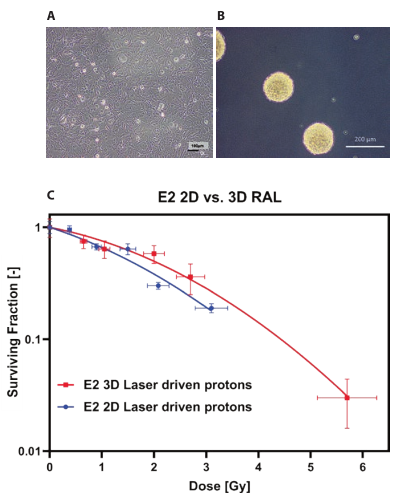
Patient-derived glioblastoma stem cells (E2 cells) were irradiated either as (A) 2D monolayers or (B) as 3D neurospheres with 35 MeV laser-accelerated protons. The effect on cell survival was studied using Clonogenic assay, as shown in (C) where the red curve shows the dose response of 3D neurospheres and blue curve shows the dose response of 2D monolayer cells. [Chaudhary et al., in preparation].
From molecules to tissue models: Investigating cancer using the Octopus imaging cluster (CLF, UK)
The UK Central Laser Facility’s Octopus imaging cluster offers a comprehensive range of fluorescence-based optical imaging techniques. These are applied in a vast range of research areas ranging from plant biology to smart materials. Cancer is a complex disease and developing new treatments depends on understanding the disease from its origins at the molecular level through to the way in which it behaves in the multicellular environment of tissues. Octopus techniques have been used to investigate cancer at both ends of this spectrum.
At the molecular level, fluorescence imaging can localise individual molecules with high precision. A method known as Fluorescence Localisation Imaging with Photobleaching (FLImP), developed at the facility, allows to map out the spacing of molecules in complexes with a resolution better than 5 nm. FLImP has been used to characterise the molecular architecture of complexes of Epidermal Growth Factor Receptor (EGFR), the target of a number of drugs in clinical use and under development. Signals from EGFR are responsible for the control of cell growth and EGFR mutations are implicated in many cancers. FLImP has shown that the signalling process is more complex than previously thought, and involves the formation of large assemblies of EGFR molecules. Differences can be seen in EGFR complex architecture between wild type receptors and cancer-associated mutations. Anti-cancer drugs have also been shown to influence this molecular architecture. CLF are now working with clinicians with the aim of using FLImP to “fingerprint” biopsies from patients and determine the best course of treatment.
At the other end of the scale, Octopus has been used to look at the metabolism of tumour models with the aim of improving therapies. Solid tumours display varied oxygen levels and this characteristic can be exploited to develop new diagnostic tools to determine and exploit these variations. 3D cultures of cells, such as “spheroids”, are a good model for solid tumours. A phosphorescent, low molecular weight platinum (II) complex has been used as an oxygen sensing probe to study the variation in oxygen concentration in a melanoma tumour spheroid using one-photon phosphorescence lifetime imaging microscopy (PLIM). These measurements enabled real time oxygen mapping with high spatial resolution. This gives a valuable tool for optical detection of both physiological and pathological oxygen levels in a live tissue mass and may have the potential for broader clinical application. A related imaging method, fluorescence lifetime imaging microscopy (FLIM), has also been used to investigate the uptake of anticancer drugs into spheroids. In this case, spheroids were exposed to the drug combretastatin. These studies are important for the development of photodynamic therapy, in which inactive drug precursors are delivered to the tumour, and then made active by exposure to light. This new approach (Type IV) minimises side effects as the drug is only toxic in the tumour and not in healthy tissue and does not require oxygen.
The example projects described above demonstrate the potential for laser-based optical microscopy to investigate different aspects of this complex and difficult disease. These methods will continue to play an important role, as new developments take place in techniques, instrumentation, new chemical probes, and sample preparation. Octopus and its team will continue to work with researchers in this important endeavour.
David Clarke, Stan Botchway, Marisa Martin-Fernandez (CLF)

FLImP studies of EGFR. a) Image of cancer cells showing individual EGFR molecules and complexes. b) Model of a multimer of EGFR derived from distance measurements obtained by FLImP. From Zanetti-Domingues et al., Nat. Commun. 9: 4325, 2018.
Non-linear microscopy offers improved tumour biopsies (IESL-FORTH, Greece)
The development of label-free non invasive techniques to be used as new tools in cancer research is of great importance. Non-linear optical imaging techniques, based on the employment of ultrafast lasers as excitation sources, have been widely used to reveal biological structures for accurate diagnosis at the cellular as well as the tissue level [1, 2]. These technologies provide several advantages compared to other optical techniques such as high resolution, label-free imaging capabilities, increased penetration depths and intrinsic three-dimensional sectioning, while the phototoxicity phenomena onto the biological sample are minimized. Non-linear imaging can provide complementary information on autofluorescence, inhomogeneities, as well as collagen distribution of tissue samples at the submicron level. Recently, this approach has been applied on live tissue with very promising results and has therefore been proposed for clinical studies.[3].
At the Non-linear Microscopy lab (NLM Lab) of IESL- FORTH qualitative and quantitative information concerning the structure and directionality of collagen fibers in thin breast tissue sections was collected using second- harmonic generation (SHG) and polarisation-dependent SHG (PSHG) imaging measurements. Collagen, which has been considered as cancer biomarker, is an ideal emitter of high SHG signals due to its non-centrosymmetric structure. Collagen fibers that could be detected by SHG imaging showed a well structured continuity in benign tumour tissues, which became less well-structured as the disease became more severe. Moreover, the obtained results indicated that PSHG data analysis can correlate the calculated second-harmonic anisotropy parameter values with tumour progression. Specifically, the analysis suggested that PSHG imaging could provide a quantitative evaluation of the tumour state and the distinction of malignant from benign breast tissues [4]. Furthermore, using a single femtosecond laser beam, label-free third harmonic generation (THG) imaging techniques provided additional important morphological information as to the mean nuclear and cytoplasmic area, cell volume and tissue intensity, which upon quantification could not only distinguish cancerous from benign breast tissues but also define disease severity. Thus, THG signals which arise from breast tissue discontinuities, from multilayered structures detected in membranes and from lipid bodies, can associate the tissue inhomogeneities with the grades of cancer severity [5, 6]. The applied approach has clinical potential, since it could be used for the quick characterisation of newly excised thin biopsy samples.
Non-linear microscopy techniques (SHG, PSHG, THG) make it possible to quantitatively differentiate benign from cancerous thin human breast biopsy samples, promising a faster, label-free diagnosis. This work could be a step forward for the development of new, non-destructive optical diagnostic tools, based on ultrafast laser oscillators emitting in the near infrared region of the spectrum, for reducing recalls and unnecessary biopsies, while maintaining or improving cancer detection rates, thus improving the quality of life.
This interdisciplinary study was a collaboration between the Non-linear Microscopy (NLM) group of IESL- FORTH, the Biology Department of University of Crete (Prof. Athanassakis group) and the Medical School of the same University.
George Filippidis (IESL-FORTH)
[1] M.G. Giacomelli et al., Biomed. Opt. Express 9: 2457, 2018
[2] E. Gavgiotaki et al., J. Biophotonics 10: 1152, 2017
[3] S.X. You et al., Nature Communications 9: 1, 2018 [4] V. Tsafas et al., submitted
[5] E. Gavgiotaki et al., Proc. SPIE 11076: 110760I, 2019
[6] E. Gavgiotaki et al., in press Scientific Reports
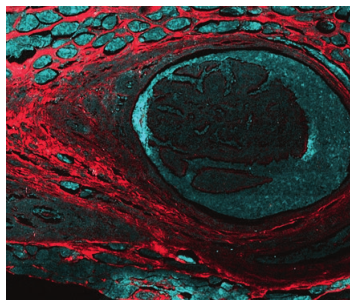
Multimodal non-linear image of malignant (grade II) breast tissue. SHG depicted in red and THG in blue color. Scale bar depicts 100 μm.
Photoacoustic imaging – clinical implementation of a novel diagnostic tool for skin tumour delineation (LLC, Lund University, Sweden)
The ‘gold standard’ method for skin tumour diagnosis requires surgical incision and histopathological analysis to determine the nature of the lesion and the extent to which it may have grown. Patients with non-radical excisions must undergo a second surgery to completely remove the tumour. If the complete dimensions of the tumour, both laterally and at a depth, could be determined non- invasively, it could reduce the number of surgical incisions drastically as well as save time and patient suffering.
Photoacoustic imaging (PAI) is one of the most promising imaging modalities emerging for clinical use as it is capable of generating an image of the tissue down to a depth of 2 cm. This is acquired by sending a train of ns laser pulses into the tissue, which consequently absorb and generate a thermo-elastic expansion that is detected by a high-frequency ultrasound transducer. By tuning the photon energy of each laser pulse, an absorption spectrum is acquired at every point resolved by the ultrasound probe (typically 200 um resolution). At the Lund University, spetroscopists are working in close collaboration with medical doctors to develop PAI for clinical implementation, with particular focus to determine the 3D dimensions of a suspected tumour non-invasively. Specifically, they were among the first to translate the PAI technique into the clini- cal setting [1], and are therefore uniquely placed to implement it for skin cancer in patients. They were also the first to demonstrate the ability of PAI to discern basal cell carci- noma [2] and squamous cell carcinoma [3].
In an ongoing study, PAI and related spectral imaging analysis methods are being tested on excised skin tumours of different types. As shown in the figure, promising results have been obtained in generating a 3D reconstructed image of the sample in which the dimensions of a melanoma skin tumour can be determined. Ultimately, the project aims at developing a clinically viable method for skin tumour diagnosis capable of identifying and delineating skin tumours within minutes so that the tumour can be removed in a single-stage procedure.
Malin Malmsjö (Lund University)
[1] R. Sheikh et al., IEEE Trans. Ultrason. Ferroelectr. Freq. Control 66: 472, 2019
[2] U. Dahlstrand et al., Photoacoustics 18: 100187, 2020
[3]J. Hult et al., J. Biophotonics 13: e201960212, 2020
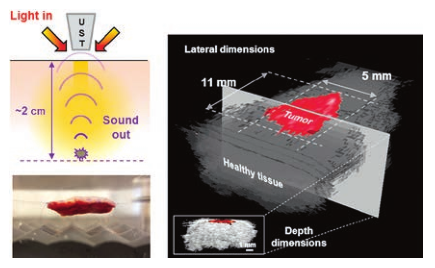
Top left: The schematic demonstrates how light from a pulsed tunable laser source penetrates the tissue where absorption of photons generates a thermoelastic response detected by an ultrasound transducer (UST). Bottom left: A picture of an excised tumour that is imaged using PAI from which a 3D reconstructed image can be recreated. Right: Employing spectral unmixing algorithms, the tumour can be distinguished from healthy tissue, and its dimensions can be determined both laterally and at a depth.

